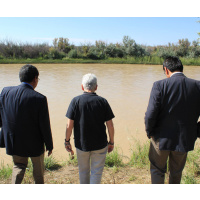Navajo Nation Holds EPA Responsible for Poisoning of River by Colorado Mine Disaster
 (L to R:) Russell Begaye, Gina McCarthy and Navajo VP Jonathon Nez view polluted San Juan River (photo: Facebook)
(L to R:) Russell Begaye, Gina McCarthy and Navajo VP Jonathon Nez view polluted San Juan River (photo: Facebook)
By Julie Turkewitz, New York Times
DENVER — The Navajo Nation filed a lawsuit on Tuesday against the Environmental Protection Agency and several corporations, saying that poisoned water that flowed from a punctured Colorado mine last year disrupted hundreds of lives near a critical watershed.
The disaster, the federal suit says, has heightened economic and spiritual pain in a region hamstrung by poverty and drought. The tribe is seeking to hold the agency and corporations accountable, be made whole for at least $2 million spent on testing and alternative water sources and be compensated for lost revenue and psychological damages.
“We cannot just sit back and let the EPA do what they’ve been doing, just doling us pennies,” said the president of the Navajo Nation, Russell Begaye, in a telephone interview. “This river is the main river that gives life to the whole region, not just those who live around the river, but the entire nation. This is our lifeblood. It is sacred to us.”
A spokeswoman for the EPA, Nancy Grantham, said the agency could not comment on active legal issues. Representatives from the mining companies and the EPA contractors declined to comment or did not return messages.
The lawsuit stems from an August 2015 episode in which contractors hired by the EPA to assess a shuttered gold mine — the Gold King in southwest Colorado — accidentally broke the mine’s seal, causing about 3 million gallons of chemical-laced orange sludge to flow into the Animas River south of the mine and then into the San Juan.
An image of three kayakers on the Animas River became a neon media sensation, drawing attention to a problem that continues to plague the West: The region has thousands of old, acid-filled mines, some leaching into waterways, others that could burst at any time. The mines have filled with poison from water and air entering earth cavities, mixing with sulfurous minerals.
The EPA took responsibility for the accident and has spent $29 million to address cleanup and compensate communities, including the Navajo Nation. But people along the spill’s path have continued to feel its effects. The sludge coursed through Colorado, New Mexico and Utah. The EPA is considering whether to declare the area around the Gold King a Superfund site.
The Navajo reservation, a vast region of red rocks that sits south of the mine, was hit particularly hard by the spill because leaders told people not to use water from the San Juan River for weeks after the EPA said it was safe. Begaye, the Navajo president, said he was wary of the claim that the stream was healthy enough for agricultural and other use.
Irrigation lines were cut off. Corn, melons, hay and wheat never made it to market. The spill, the president said, delivered a psychological lashing in a drought-stricken place where water is gold, many live in poverty and the San Juan River holds financial and spiritual power.
The lawsuit names several defendants: the EPA; two contractors called Environmental Restoration and Harrison Western; four mining companies called Gold King Mines Corp., Sunnyside Gold Corp., Kinross in Canada and Kinross USA; and 10 unnamed individuals.
It alleges that mismanagement of the mine, which had been closed for years but never cleaned up, caused it to swell with toxic water and eventually burst. The suit says that 880,000 pounds of metals spilled out when the Gold King burst, and that roughly 80-90 percent remains embedded in the river upstream, ready to flush into the Navajo Nation during rains and storms.
Near the Gold King in Colorado, toxic water continues to flow out of the mine at a rate of 570 gallons a minute. A nearby water treatment plant put in place by the EPA removes 95 percent of contaminants.
The agency says that the water below the mine and the treatment facility has generally returned to prespill conditions, and local governments have instructed residents to resume recreational and agricultural activities on the Animas and San Juan Rivers.
The suit is the latest to come out of the mine blowout. Earlier this year, New Mexico sued the EPA and the state of Colorado over the accident. And the EPA’s Office of the Inspector General has opened a criminal investigation into the spill.
To Learn More:
States and Tribes Bracing for Emergence of Toxic Metals from Rivers Contaminated by EPA Mishap (by Dan Elliott, Associated Press)
Utah Taking Legal Action Against EPA Over Mine Waste Spill (by Lindsay Whitehurst, Associated Press)
880,000 Pounds of Metals Landed in Animas River from EPA-Triggered Colorado Mine Spill (by Dan Elliott, Associated Press)
After Toxic Spill in Colorado River, Mining Companies Avoid Responsibility for Cleanup Thanks to Outdated 1872 Law (by Noel Brinkerhoff and Steve Straehley, AllGov)
Oops…EPA Causes 3 Million-Gallon Wastewater Release into River (by Noel Brinkerhoff and Danny Biederman, AllGov)
Private Contractor Conducting Work that Led to Toxic Waste Spill in Colorado River has Received more than $350 Million in Federal Contracts (by Noel Brinkerhoff and Steve Straehley, AllGov)
Water Shortages Not Just in California—Puerto Rico and Navajoland Also Hit (by Noel Brinkerhoff and Steve Straehley, AllGov)
- Top Stories
- Unusual News
- Where is the Money Going?
- Controversies
- U.S. and the World
- Appointments and Resignations
- Latest News
- Trump to Stop Deportations If…
- Trump Denounces World Series
- What If China Invaded the United States?
- Donald Trump Has a Mental Health Problem and It Has a Name
- Trump Goes on Renaming Frenzy






Comments